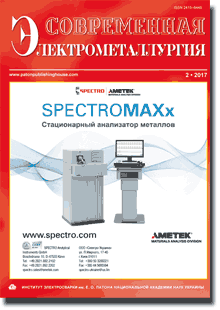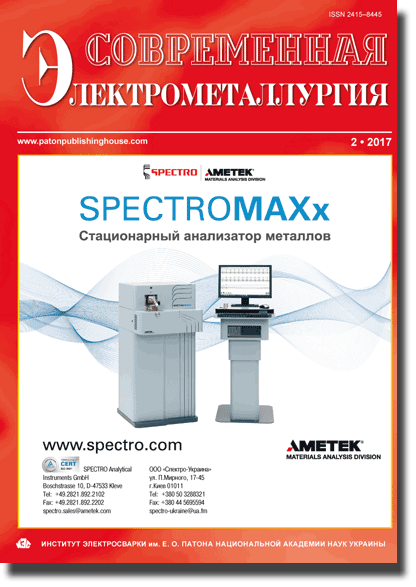| 2017 №02 (05) |
DOI of Article 10.15407/sem2017.02.06 |
2017 №02 (07) |

Electrometallurgy Today (Sovremennaya Elektrometallurgiya), 2017, #2, 35-44 pages
Modeling of metallurgical additive process of manufacture of 09G2S steel structures
G.M. Grigorenko, V.A. Kostin, V.V. Zhukov
E.O. Paton Electric Welding Institute, NASU. 11 Kazimir Malevich Str., 03680, Kiev, Ukraine. E-mail: office@paton.kiev.ua
Presented are the results of modeling the thermal fields, stresses, deformations and displacements in formation of additive structures of steel 09G2S on substrate. To carry out the computer modeling, a calculation package of interdisciplinary investigations COMSOL Multiphysics was used. In the work the effect of temperature on steel physicalchemical parameters was taken into account. Results for modeling were obtained by using a complex Gleeble 3800 of simulation of thermodeformational state of a thermal cycle of metal welding under the action of tension (coefficient of linear expansion) and unit VDTA-8M of high-temperature thermal analysis (heat capacity, heat conductivity). The carried out investigations showed that at the additive deposition of steel 09G2S layers on substrate the highest level of residual stresses and deformations is reached at the interface of the first layer and substrate and amounts to 280…320 MPa. The stresses between the deposited metal layers are significantly lower (to 50 MPa). It was found that with increase in the number of depositing layers the level of stresses at the additive layer/substrate interface is increased and does not depend with time on the deposited layer number. During the additive process it is necessary to apply the preheating up to temperatures of not lower than 300…320 oC to prevent a noticeable deformation of the substrate. The developed software can be used for the mathematical modeling of the additive process of formation of structures of steels, titanium and aluminium alloys. Ref. 13, Table 1, Figures 7.
Keywords: additive production; modeling; steel; deposition; stress; microstructure
References
1. Zhukov V. V., Grigorenko G. M., Shapovalov V. A. (2016) Additive manufacturing of metal products (Review). The Paton Welding Journal, 5–6, 137–142. [in Russian]. https://doi.org/10.15407/tpwj2016.06.242. Akhonin S. V., Vrzhizhevsky E. L., Belous V. Yu., Petrichenko I. K. (2016) Electron beam 3D-deposition of titanium parts. The Paton Welding Journal, 5–6, 130–133. [in Russian]. https://doi.org/10.15407/tpwj2016.06.22
3. Korzhik V. N., Khaskin V. Yu., Grinyuk A. A. et al. (2016) 3D-printing of metallic volumetric parts of complex shape based on welding plasma-arc technologies (Review). The Paton Welding Journal, 5–6, 117–129. [in Russian]. https://doi.org/10.15407/tpwj2016.06.20
4. Kaufui V. Wong, Aldo Hernandez (2012) A review of additive manufacturing / International Scholarly Research Network. Mechanical Engineering, 2012, 10 p. doi 10.5402/2012/208760.
5. Rizwan P. M. Ali, Hara Theja C. R., Syed Saheb S. M., Yavaraj C. (2015) Review on diverse materials applied for additive manufacturing. International Journal for Research in Applied Science & Engineering Technology, 3, July, 16–20.
6. Ding D., Pan Z., Cuiuri D., Li H. (2015) Wire-feed additive manufacturing of metal components: technologies, developments and future interests. International Journal of Advanced Manufacturing Technology, 81, 465–481. https://doi.org/10.1007/s00170-015-7077-3
7. Shapovalov V.A., Grigorenko G.M. (2015) Metal structure control during solidification. Sovremennaya elektrometallurgiya, 2, 51–54. [in Russian]. https://doi.org/10.15407/sem2015.02.08
8. Shapovalov V. A., Grigorenko G. M. (2015) Supression of liquation processes in large ingots. Sovremennaya elektrometallurgiya, 1, 26–30. [in Russian]. https://doi.org/10.15407/sem2015.01.05
9. https://www.comsol.com/.
10. Kostin V. A., Zhukov V. V. (2016) Modelling the processes of metallic parts production using additive technology methods. Proceedings of Eighth Inter. Conf. «Mathematical Modeling And Information Technologies in Welding and Related Processes », 19–23 September 2016, Odessa, Ukraine. [in Russian].
11. http://tehtab.ru/Guide/GuidePhysics/GuidePhysicsHeatAnd Temperature/ConvectionHeatTransfer1/Overa.llHeat TransferCoefficients/
12. Makhnenko O. V., Milenin A. S., Velikoivanenko E. A. et al. (2017) Modelling of temperature fields and stress-strain state of small 3D sample in its layer-by-layer forming. The Paton Welding Journal, 3, 7–14. https://doi.org/10.15407/tpwj2017.03.02
The cost of subscription/purchase order journals or individual articles
| Journal/Currency | Annual Set | 1 issue printed |
1 issue |
one article |
| TPWJ/USD | 384 $ | 32 $ | 26 $ | 13 $ |
| TPWJ/EUR | 348 € | 29 € | 24 € | 12 € |
| TPWJ/UAH | 7200 UAH | 600 UAH | 600 UAH | 280 UAH |
| AS/UAH | 1800 UAH | 300 UAH | 300 UAH | 150 UAH |
| AS/USD | 192 $ | 32 $ | 26 $ | 13 $ |
| AS/EUR | 180 € | 30 € | 25 € | 12 € |
| SEM/UAH | 1200 UAH | 300 UAH | 300 UAH | 150 UAH |
| SEM/USD | 128 $ | 32 $ | 26 $ | 13 $ |
| SEM/EUR | 120 € | 30 € | 25 € | 12 € |
| TDNK/UAH | 1200 UAH | 300 UAH | 300 UAH | 150 UAH |
| TDNK/USD | 128 $ | 32 $ | 26 $ | 13 $ |
| TDNK/EUR | 120 € | 30 € | 25 € | 15 € |
AS = «Automatic Welding» - 6 issues per year;
TPWJ = «PATON WELDING JOURNAL» - 12 issues per year;
SEM = «Electrometallurgy Today» - 4 issues per year;
TDNK = «Technical Diagnostics and Non-Destructive Testing» - 4 issues per year.





